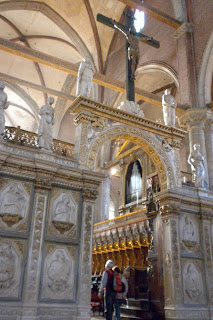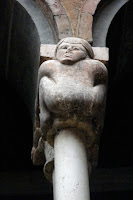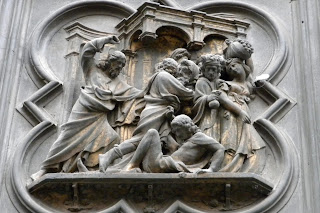We made a relatively early start to our last day in Italy, in order to fit in the key sights of Venice before we head home tomorrow. Since the transportation system here is so complex, Dad wanted to go down to the pier to try to figure out how to get to the airport tomorrow. Unsurprisingly, the only vaporetto that services the airport is run by a separate company than the one that serves the town (and for which we bought a 48 hour pass), so it will take another 15€ per person, plus 3€ for each piece of baggage in the morning. I think Dad was put off by the hour plus trip via this form of public transit, so I think he'll opt for airport transfer via private water taxi, which will cost about 120€, but will only take 20 minutes and will give him better peace of mind. Meanwhile, I'm starting to see the case for coming here as a day excursion from a cruise -- trying to manage your own transportation here is an expensive nightmare!
 |
| Somehow I managed to leave Venice without taking a decent photo of the Basilica. This will have to suffice. |
With a better understanding of the situation for tomorrow, we headed back into the Piazza San Marco to get in line to see the eponymous basilica. It's always been a rather sore point for me that I only got to see the outside the last time I was here, but unlike my similar beef with the Duomo in Florence, this long-simmering resentment was totally warranted -- the inside was incredible. Though I couldn't get a decent photo of it, as I was once again acting on the sly in defiance of the no photography policy (what is with this country?!?), almost the entire interior was covered with glittering gold mosaics. The churches in Ravenna may have the basilica beat in terms of age and the renown of their pieces, but the Basilica of San Marco could have fit all those mosaics on top of their own and still had plenty left over.
 |
| Next trip, I'm going somewhere where I can shamelessly take as many photos as I want without having to sneak around. |
In fact, given that many of its decorations were stolen from elsewhere, it's somewhat surprising that no wily Venetians pried some of those Byzantine pieces off the walls in Ravenna to bring them home. They had no qualms stealing the horses from the top of the Hippodrome in Constantinople and putting them over the main portal to the church, and absconding with the remains of St. Mark himself from his previous resting place in Alexandria and bringing him to the church they were building in his name. Legend has it, the Venetians smuggled the remains out of the Egyptian city under sides of pork, so that the tomb's Muslim guards wouldn't be tempted to look under the "unclean" meat and discover their illicit cargo.
 |
| Mosaics and decorations over one of the portals to the church. |
As it turns out, the city government actually promoted this practice: starting in 1075, all ships traveling abroad had to return with a treasure for San Marco, by law. Considering that until 1807, the entire enormous basilica was the doge's private house of worship and otherwise used only for ceremonies of state, this was a particularly interesting demand.
 |
| Here, you can see the proximity of the Palazzo to the Basilica, for the Doge's personal worshiping comfort. |
Having seen the church and all the vast treasures it contained, we walked next door to see the palace of the doges, or Palazzo Ducale. As we strolled through the elaborately decorated rooms, designed to showcase the wealth and power of the Venetians, as well as strike fear into any who dared to run afoul of the local government, we tried our best to glean what we could about its complicated structure, which consisted of numerous layers of councils. Given that they had no formal constitution, it's amazing that their convoluted system was able to function well enough for them to become the imperial power that they were.
Dad was particularly interested in the palazzo's armory collection, one of the largest in Europe. The palace apparently kept a massive stockpile of weapons on hand in case anyone tried to usurp the doge's authority. I was mostly just amazed that anyone could heft some of those weapons, much less put them to effective use.
With our respects duly paid to the golden age of Venetian prosperity, we decided to make a contribution to their current prosperity by doing some shopping. After all, it seems like the principle pastime here, and at the end of our trip, we were finally in a position to be acquiring souvenirs when we wouldn't have long to schlep them around. We made a brief pause for a miserably inauthentic pizza lunch that tasted like something an American chain pizzeria might serve, but after so many good meals on this trip, perhaps we were past due for a bad one..
 |
| The whole canal situation makes it impossible to stand far enough away to get a decent shot of the church. |
In the afternoon, we took the vaporetto across the Grand Canal once more to visit Santa Maria della Salute (or Saint Mary of Health), an enormous church that had caught both our attention when we passed it on the vaporetto. Built in 1630 in thanks for the city being spared from the plague of the same year, the church is a baroque masterpiece. I found it rather more impressive on the outside than the inside, save for an allegorical sculpture over the altar of the Madonna and Child granting a blessing to Venice, as symbolized by a woman, while on her other side, a less-fortunate figure writhes in terror and agony.
 |
| Even when giving thanks, the Venetians manage to express their overblown egos. |
In desperate need of a break from the medieval, renaissance, and baroque masters after ten days, my final itinerary item for the trip was a visit to the Peggy Guggenheim Collection, a museum of works assembled by the plucky heiress herself, who was famous for "discovering" some of the greatest artists of the 20th century and furthering their careers. (In the case of Max Ernst, she went so far as to marry him.)
The collection is housed in a unusual villa where Guggenheim lived with her daughter, an artist in her own right. All the greats of modern art were there: Pollock (who had a room all to himself), Dali, Picasso, and, naturally, Ernst. I was particularly delighted to see some paintings by Italian artist, diChirico, one of my personal favorites, and I was surprised to actually enjoy a work by Brancusi: "Maiastra," which portrays a singing bird. Normally, his minimalist aesthetic isn't my style. The only piece Dad and I agreed upon was Boccioni's Futurist masterwork, "Unique Forms of Continuity in Space," which we both loved. In fact, that Dad was able to enjoy the Guggenheim Collection at all without being bored to tears is a testament to the artistic burnout we've both suffered on this trip -- normally, he has some difficulty stomaching abstract and non-objective art.
 |
| Fall, in my opinion, is always the best time of year to travel, and this is partially why. |
After completing our tour, we lingered on the less crowded side of the canal, doing some more shopping and enjoying a breather away from the masses, before cramming onto a vaporetto and heading back. Tired and weary at the end of our journey, we took the path of least resistance and had a quick bite of dinner at the restaurant closest to the hotel, which was, hands down, the worst meal of the trip.
Although our trip ended on a bit of a culinary down note, and in spite of my father being trying at times, there is no denying that we had a very full ten days. We saw truly amazing things, and each of us managed to scratch items from our respective bucket lists: the David for Dad, and the mosaics of Ravenna for me. I've been very fortunate to have this opportunity, and I'm sure I'll look back and be grateful for having so much quality time with my father. I do love to travel, and I can't wait to see where life will take me next!










































